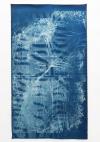- Nina
|
A corps perdu
The specificity of a « Pure Form » work of art would, according to I. Witkiewicz, manifest itself through “unity in multiplicity” . The work of art in its unity is the reflection of the individual who creates it; it is the transposition, the translation into “pure form”, in a metaphysical sense. To a certain extent, this is what Nina Roussière explores and investigates in her practice of drawing, through a complex and empirical approach, whether it is on paper or canvas, or in photography: she engages a battle in which her life, time, art, a context period, are metaphorically staged. Following a rigorous process, the artist puts language into perspective (its history, the elastic density of the evolution of glyphs from original to digital ones), the drawn lines translate into digital signals on the screen. Somehow, Nina produces the “skeleton” of a timeless universe. There is a process of emergence. Forms are unstable and shifting, pregnant with one another, algorhythms connect them according to imposed directions in order to enact a mutation. She believes (or likes to believe) that, beneath the surface, objects and events are intricately interwoven. The “constellations” that are thus created are printed and at times, literally absorbed by the restricted space of the machine (a printer). The artist then engages in a struggle against the mechanical rhythm, having to let go, to exert pressure, to hinder the process, in order to obtain a “slice of life” , of her life. The body is there, present in the tension and pressure it imposes upon the machine. In such struggle and “failure”, grace and self-forgetfulness emerge as well as an unpredictable and unique form that marks (imprints) the drawing. Then, it is time for the charcoal expression, the artist’s gesture , looking for the “Pure Form”, a gesture that enables the artist to position herself in/on the drawing. She crushes the charcoal on the paper, blows a breath of wind upon it, and offers a movement. The action is palpable, perceptible. The trace of the hand indicates a moment, an ephemeral present. The works of Nina Roussière are an endless source of fascination and metaphysical reflections; they project us into a timeless universe where the dialogue between subtle bodies and digital signals nurture a singular metalanguage that invites us to observe the infinite vibrations of the drawing.
Christian Laune |
 français |





